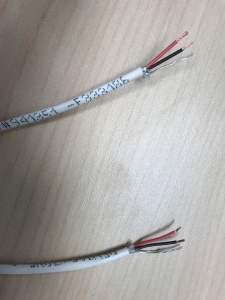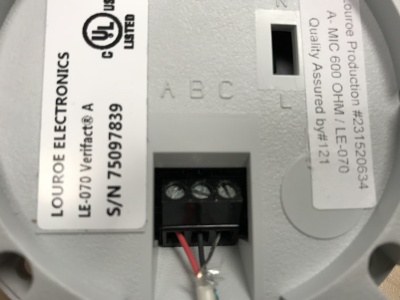Installing an Axis P3235 with a Louroe Verifact A Microphone
Required Parts and Tools
- Axis P3235
- 3.5mm (Male to Male) Audio Cable
- Louroe Verifact A Microphone
- T20 Torx security bit
- Wire Stripper
- Wall Dogs (if mounting to concrete) (3/16")
- Screws and Anchors (3/16")
- Toggle bolts (If mounting to drop ceiling tile) (3/16")
- 1/2" paddle bit
- 3.5mm Audio Cable
- Toggle Bolts (for mic mount)
- Drill bit and drill
- Phillips head drill bit or Phillips head screwdriver
- Small Flat head screwdriver (#3)
- Hole Saw
- B Connectors
- Stud Finder
- Cat5/6 Patch Cable (7ft-15ft recommended)
- Shielded Stranded 22/2 + ground Wire
- Fish Tape or Glow Rods
Installation Instructions
- Locate the network drop above the ceiling either being a male Ethernet end (service loop) or a biscuit jack. This will have been ran back to the POE switch. If the switch does not have POE, a POE injector will need to be installed at the network closet.
- Using the T20 bit, remove the dome from the 3235. Remove protective foam and remove the camera from the mounting plate.
- Determine the mount location of the 3235. If mounting to dry wall, use a stud finder, ensure the mount location is free of being located on a stud. Using a pencil, mark either two or four of the holes for the mount plate. Using a 3/16" drill bit, drill the marked locations and install anchors and attach the mount plate. Using a hole saw or paddle bit, cut a hole centered among the wall plate where cables will pass through.
- If mounting to drop ceiling, determine where the camera will be located on the tile. Ensure that there will be clearance on the tile to secure the dome in place. Using two toggle bolts, secure the mount plate. Using a 1" paddle bit, drill a hole centered among the wall plate where cables will pass through.
- Connect the network drop into the Ethernet port on the Axis P3245. When connected, activity will be visible on the link lights. If no link lights appear, ensure that POE is enabled on the POE switch and that the network drop is plugged in. After approximately one minute, all three LEDs should be green. If not, troubleshoot connections.
Connecting the Microphone
- Strip the jacket off the 22/2, revealing the red, black, and common (bare wire) on both sides of the cable. Remove the string and plastic casings covering the red and black cables. Strip the red and black jackets off the wire exposing the copper. Cut copper evenly on both ends. On the cable ran for power, cut off the common (bare wire) completely as it will not be used. (See picture)
- Cut a 3.5 mm audio cable in half. Strip about an inch of the black jacket; then strip about 1/2 inch of red and white strand jacket. Test the 3.5 cable for polarity (touch one end of the cable tester to the tip of the 3.5 jack and the other end to the red and white wires. This will be the positive wire; the middle section of the 3.5 jack is negative wire; the bottom section of the jack is ground/stranded wire.) Splice these wires with the camera end of the 22/2 cable ran for audio. Red to A, Black to B, Common (bare wire) to C (See Picture)
- Connect the power cable to the IO phoenix connector (Red to 2, Black to 1).
- Plug in the network drop to the camera network port, the 3.5 jack into the pink AUDIO IN port on the camera, and the IO Phoenix connector to the IO port.
- You will also need to cut a 3” piece of 22/2 cable, but only the inner red wire. Strip ¼” of the jacket from both ends of the cable. Insert and secure this wire as a jumper from Phantom+ to Power+.
- Place the dome over on the camera. Using the T20 bit, tighten the dome cover in place.

